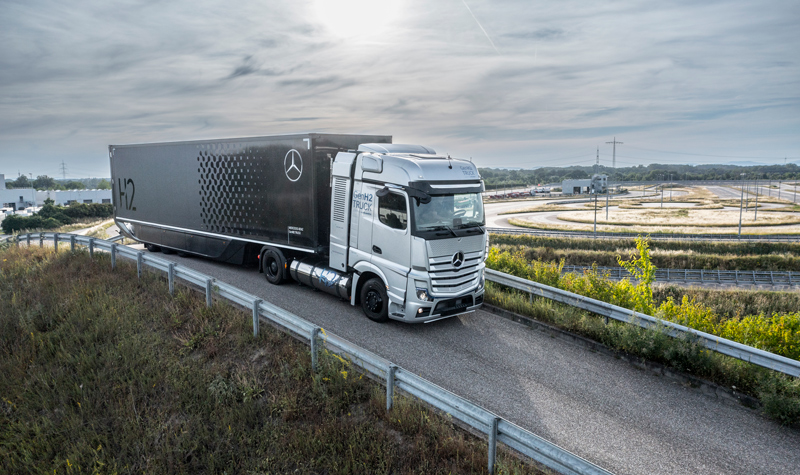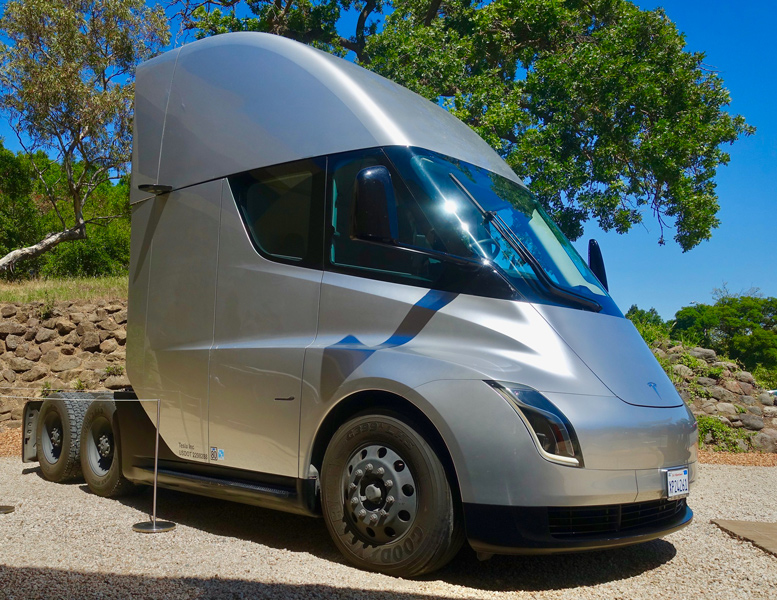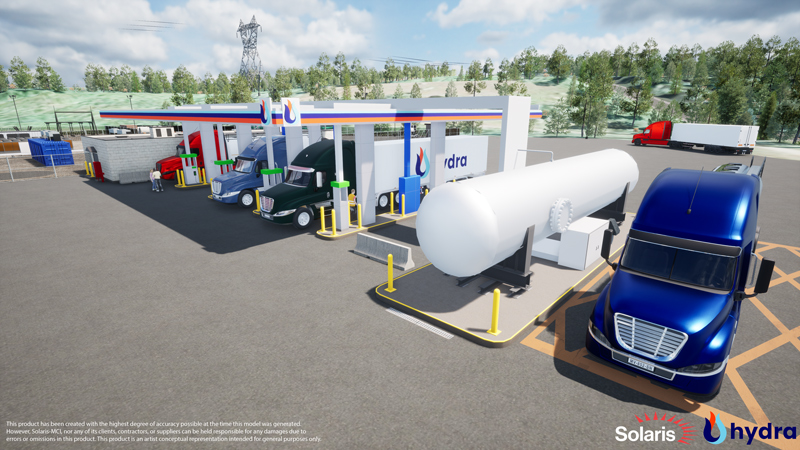Account Login
Don't have an account? Create One

Sixth in a nine-part series
Should it come to pass, broad use of hydrogen for trucking in Canada, particularly Atlantic Canada, is still many years away. At this point, vehicle manufacturers around the world are working to show transport companies they have machines with the range and service they need, while service companies are trying to identify locations for support infrastructure and staff, how to finance both, and at what speed it makes sense to extend their services. No one has sorted out where all the power is coming from for zero-emission vehicles (electric and for making hydrogen). And ultimately there is an uncertain market share for hydrogen in next-generation fleets.
The owners of some of the largest transport fleets are looking at the low-carbon economy and quietly trying to figure out the best investments for their future. In Canada, that includes Hartland, N.B.-based Day & Ross. Atlantic Business Magazine was told the company was “investigating” emerging zero-emissions vehicle options, but not ready to comment, and there was no response from similarly positioned Armour Transportation.
At the Atlantic Provinces Trucking Association (APTA), executive director Chris McGee said, to the best of his knowledge, the APTA has some members “leading the charge with new tech in this space,” making a general reference to engine manufacturers. However, he stated the APTA, “has not done a significant amount of work into investigating the benefit of hydrogen.” And collectively, companies in the region are not yet signalling any plans to rapidly transition to hydrogen use or even hydrogen as a clear option.
Hydrogen isn’t off the table entirely. But the here and now view on hydrogen trucks in Atlantic Canada? “My understanding is that it is still a ways off,” McGee stated. That’s just the reality.
Long-haul routes not available
Uncertainty is to be expected at the moment. As Volvo stated in their self-published guide, Alternative Fuels for Trucks: “Optimism about alternatives to diesel is rife across the board.”
In laying out pros and cons on hydrogen, the company highlighted things like longer ranges versus trucks relying on lithium-ion batteries but also the fact fuel cells are expensive to produce and hydrogen is being made almost entirely using fossil fuels.
As with light-duty vehicles, there have been obvious barriers to any adoption of hydrogen vehicles for commercial trucking, even more readily available models for shorter routes and smaller payloads. One clear consideration? Even if you have a vehicle today (and they exist, if few in number) capable of running off of hydrogen fuel cells, you’re hard pressed to find a fueling station in most of North America.
Is there a network of commercial stations stocked with “green” hydrogen, made only from renewables? No.
Commercial transport has the benefit of allowing for fewer stations, with depots and refueling centres along standard routes, unlike the demands for regular cars and trucks and a corner “gas station,” but the refueling options for truckers still need to be plentiful enough to support standard operations. Canada is a vast country, with long stretches of highway. With so few hydrogen refueling stations of any kind, it hasn’t made sense to even begin mapping possible “fuel corridors” that could safely and economically connect provinces, and someday allow for trans-Canada hauling by hydrogen vehicles.
In the U.S., the Department of Energy offers a map at least showing emerging fuel corridors, indicating stretches where there are stations at least every 150 miles (just over 240 kilometres). Currently, there are no ready corridors running through states like Maine, New Hampshire and Massachusetts. There are short links between some major centres, like Albany to Buffalo, New York, though almost all of the routes are shown only as “pending,” awaiting opening of proposed refueling centres. Overall, long haul routes for commercial trucking with hydrogen don’t exist yet anywhere but a small section of the California coast.
Into testing
There are hydrogen vehicles though, and they’re not just on paper. Companies are promising they will revolutionize the transportation industry with models that have seen initial pilot projects, but it’s fair to say it’s still early days. For example, a partnership between Toyota and American truck manufacturer Kenworth developed a hydrogen fuel-cell semi truck (picture big rig, 18-wheeler), based on Kenworth’s T680, tested starting in 2021 at the Port of Los Angeles. “(Kenworth) projects its zero-emission truck production will ramp up from fewer than a thousand trucks now to more than 70,000 in 2030 and over 180,000 in 2040,” stated a Toyota corporate post on the project. Shell and Air Liquide also partnered, for fueling stations and hydrogen supply. The fuel cell trucks come with an estimated range of about 480 kilometres (300 miles) and the truck companies have suggested newer vehicles could get closer to 400 miles, though the proof will always be in the demonstrations and regular operations.
Industry leader Daimler Truck offers the Mercedes-Benz GenH2 Truck fuel-cell prototype. The company was working with Air Liquide last summer testing refueling and the company has also worked with Linde on the processes for handling of liquid hydrogen. The goal is to have the GenH2 reach a range of 1,000 kilometres and more. That work continues. “The start of series production for hydrogen-based trucks is planned for the second half of the decade,” the company has stated.

Daimler Truck has a goal of offering only carbon-neutral machines in its core markets globally by 2039. When it comes to the issue of availability of fueling stations, the company has been in talks with Shell, BP, TotalEnergies and is a shareholder in H2 MOBILITY Deutschland, a hydrogen filling station operator. It’s also part of the H2Accelerate interest group, pushing to get to mass rollout of hydrogen trucks in Europe. Financing stations remains an issue. Like some others in transportation, Daimler is still working on both battery-electric and hydrogen-based machines.
As new vehicles get an increasing amount of attention, transport companies have to weigh the value of what they’re hearing. Range is one consideration, and estimated distances can be affected by structural or cargo weights, topography, even type of road surface and temperature. But there’s also the business of freight. A truck design may sacrifice too much weight to batteries, for instance, or too much space to larger hydrogen tanks, affecting calculations for what will be profitable for companies in their day-to-day. Refueling locations and time to refuel matters. Fuel costs, a key factor in operational costs for truckers, can be significantly affected by the chosen fuel type (electricity, hydrogen, alternative fuels) and availability to a hyperlocal level.
Even just on range, testing needs to ultimately happen specific to place. In that sense, both industry and regulators are really just starting to get a handle on what will work in Canada for distance trucking. While not a big topic yet in Atlantic Canada, the BC Trucking Association and Alberta Motor Transport Association have been looking into hydrogen options. At the APTA, McGee said there are close ties with these associations and the local association would leverage knowledge coming from out West.
Electric deliveries
According to B.C. Trucking Association president and CEO Dave Earle, there’s a lot to talk about. Some people look and still call zero-emissions trucks just hype, while others are calling it hope but no one is calling it a done deal.
“The really cool thing is we’ve made amazing strides and stuff is starting to come to market. (But) I got to tell you, we’re a long ways away from seeing stuff really take hold,” he said.
Earle said there is one area where the transition to low-emissions fleets is further along. That’s in the category of “local P and D,” or pickup and delivery vehicles. These are smaller than a Class 8 big rig but larger than your everyday pickup trucks and delivery van. Truck classifications are by weight and so these are anywhere from Class 3 (10,001 to 14,000 lbs) through more rarely to Class 7 (26,001 to 33,000 lbs). Think cubes and box trucks –– vehicles used for moving stacks of large packages or furniture. In that category, pairing with cargo and step vans as “last mile” trucks, battery-electric options are rushing in, Earle said. Companies like IKEA Canada have already started to make the switch to electric. IKEA plans to be fully electric for deliveries in just a couple of years.
Long-haul trucking with Class 8 tractor trailers (33,001 lbs or more) is a separate matter. “(Electric) doesn’t work and can’t work and won’t work in the long-haul world until a couple of things happen. Number one, we get battery technology where the density in the batteries is about 10 times what it is now. And number two, we figure out energy transfer at a rate of about 10 times where we are now. That’s not going to happen for a while,” Earle said, not mentioning the Tesla electric semi truck, likely related to availability. These vehicles are still very rare. The truck was announced in 2017 and has just started to roll out, with first deliveries in December 2022. Multiple reports have suggested Tesla plans to invest billions to increase production. The Wall Street Journal reported any ramp up has been trying to date, with Tesla suggesting larger numbers starting at the end of 2024.

Not having lines of heavy-duty electric transport trucks readily available for the bulk of North American buyers right now doesn’t mean hydrogen fuel cell options are ready. Earle’s familiar with the hydrogen models and points out, for starters, they’re also not easy to get hold of. “If you had $100 million today, in your pocket, I could not get you one of these vehicles to run in Canada,” he said. If one was available beyond a waiting list, he said, “oh my God is it expensive.”
Powerful possible demands
Many of the testing and demonstration projects for hydrogen trucks in North America to date have been in the Southern U.S., in conditions that don’t Canada’s climate. It’s not a match on environmental conditions and maybe even more importantly it’s not a match on service. And then there’s the issue of fueling, with Earle emphasizing it can’t also be up to a local trucking company to build and supply fuel stations.
But whether exploring electric or hydrogen options, long-haul transport needs to be filtered into the larger picture on electricity demand. He suggested a single big rig, to plug in, could demand power along the lines of what might feed 15 to 20 homes, depending on heating source. And it’s less efficient to produce hydrogen as a fuel. He called big rigs “energy sinks.”
“The math becomes really scary after a while,” he said.
“We really have to be thinking about okay, where’s this stuff going to come from? Because if we’re going to pull electricity from coal fired plants, why are we doing this?” he said.
Late last year a white paper was published based on ongoing study led by National Grid, looking at the future for refueling on highways in the U.S. Northeast. It attempted to estimate fast-charging needs across 71 sites. They found that, on the busiest days of the year, a single site might demand the same amount of electricity as a stadium (at 5 MW) or even a small town (at 20 MW). “This demand will come from not only passenger vehicles, but electric trucks and heavy-duty vehicles from public and private fleets,” it stated. By 2030, it forecasted some sites will be beyond the distribution grid and act more like industrial customers, hooking into high-voltage lines. The report’s authors pointed out, since grid interconnections and major electrical upgrades can take years, that bigger picture needs to start being worked on now. Hydrogen may not draw the electricity at the station but would similarly need significant amounts of electricity if that’s the chosen option for heavy-duty vehicles.
Last summer, McKinsey estimated that by 2035 as many as 850,000 medium and heavy-duty hydrogen trucks could be on the road in Europe, using 6,900 metric kilotons of hydrogen a year. More useful for the average person’s understanding was the company’s “for instance” example of 50 heavy-duty fuel cell trucks. Running about 500 kilometres a day, using about 8 kilograms of hydrogen per 100 kilometres, the fleet would need a little more than 2,000 kg (2 tonnes) of hydrogen a day. The Air Liquide hydrogen facility in Bécancour, Quebec was promoted in 2021 as having the world’s largest PEM (proton exchange membrane) electrolyzer for green hydrogen, a 20 MW unit supplied by Cummins. This “largest unit of its kind” can produce up to 8.2 tonnes per day, or by the McKinsey numbers, enough to cover just over 200 trucks, and little else.
Atlantic Canada will demand less power or less electrolyzer capacity than the Northeast U.S. for zero-emission trucking, but demands for zero-emission trucking remain no less in need of attention.
Hydrogen as a service
Looking at the hurdles of financing refueling stations and rapidly scaling up the number of non-emitting vehicles on the road, a lot of eyes are on Hydra Energy right now. The company is marketing “hydrogen-as-a-service” (HaaS), as a means to rapidly move off of diesel. It starts with Hydra paying to convert an existing trucking fleet, to run on up to 40% hydrogen (Atlantic Business Magazine was told it’s a proprietary bit of tech at the core, in the hydrogen-diesel retrofit for co-combustion, road tested since 2016). In return for the quick change over of a vehicle, the fleet owner agrees to source hydrogen from Hydra, under long-term contracts “at a fixed, diesel equivalent rate,” according to a company spokesperson. The fuel price is based on a third-party diesel price forecast, offering some predictability. Hydra provides the fueling station, while the updated user vehicles just pop by and fill up.

Hydra is putting the idea into practice, readying to open what they’re claiming as the world’s largest hydrogen fueling station for heavy trucks. It’s being built in Prince George, in northern B.C. The company has non-binding memorandums of understanding in hand and says it’s moving toward final contracts. The facility is due to be open next year and the company says it will serve at least 65 converted trucks. The plan is to license out the supply and service model.
The rate for fleet turnover on heavy vehicles is about 4%, so if (impossibly, given current cost and availability to start) buying only zero-emissions vehicles starting today, all transport trucks in Canada would be zero-emissions in 25 years.
Still, Earle says the pressure to change and slash emissions is already very real. “There is a major shipper in Canada as part of their next three-year cycle on goods, companies that wish to bid (for trucking) must provide tangible evidence as to how they’re reducing their GHG footprint over the term of that cycle, with an eye to being carbon neutral in the middle of the 2030s,” he said. “It’s real.”
Beyond trucks, there are also emissions goals for ferries, trains and planes, leading to talk of hydrogen, addressed in the next installment of this series.
Atlantic Business Magazine’s “Hydrogen Horizon” series is a high-level, moment-in-time look at the potential of hydrogen and its associated industry for Atlantic Canada. The level of demand for hydrogen production and the ability for Atlantic Canada to site competitive projects and service the markets, in a rapidly changing global energy sector, deserves serious and continuous evaluation.
Comment policy
Comments are moderated to ensure thoughtful and respectful conversations. First and last names will appear with each submission; anonymous comments and pseudonyms will not be permitted.
By submitting a comment, you accept that Atlantic Business Magazine has the right to reproduce and publish that comment in whole or in part, in any manner it chooses. Publication of a comment does not constitute endorsement of that comment. We reserve the right to close comments at any time.
Cancel